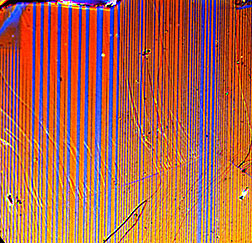A research team including scientists from the National Institute of Standards and Technology (NIST) has confirmed long-standing suspicions among physicists that electrons in a crystalline structure called a kagome (kah-go-may) lattice can form a “spin liquid,” a novel quantum state of matter in which the electrons’ magnetic orientation remains in a constant state of change.*

The research shows that a spin liquid state exists in Herbertsmithite—a mineral whose atoms form a kagome lattice, named for a simple weaving pattern of repeating triangles well-known in Japan. Kagome lattices are one of the simplest structures believed to possess a spin liquid state, and the new findings, revealed by neutron scattering, indeed show striking evidence for a fundamental prediction of spin liquid physics.
Generally, magnetism results from the magnetic moment, also called spin, of electrons within atoms. Rather than aligning in a stable, repetitive up-down pattern as they do in most magnetic solids at low temperatures, the electrons in a spin liquid are frustrated by mutual interactions from settling into a permanent alignment, so the electron spins constantly change direction, even at temperatures close to absolute zero.
Named after a mineralogist, Herbertsmithite was proposed to be a quantum spin liquid by Daniel Nocera and Young Lee of the Massachusetts Institute of Technology (MIT) in 2007. Herbertsmithite has a peculiar crystal structure in which its copper atoms lie at the corners of triangles with interactions that favor having the up-down alignment pattern of electronic spins on each corner. However, while electrons on two of the corners of a triangle can align, one up and one down, their alignment produces a quandary for the electron on the third corner, which cannot align with both.
“The electronic spin on the third copper atom essentially doesn’t know what to do with itself,” said Collin Broholm, a physicist at NIST and Johns Hopkins University, who was also part of the team that previously characterized a different material with a spin-liquid-like state.** “The locations of copper atoms in Herbertsmithite suggest the material might not be able to order itself magnetically, which is interesting because it is so unusual. But testing the hypothesis of a quantum spin liquid required the right instrument and very pure crystals of Herbertsmithite, and until recently, we had neither.”
The MIT group provided the crystals after managing to grow them artificially in their lab, a painstaking process that took years. To determine the behaviors of the electronic spins in the crystals’ copper atoms, the team used the Multi-Axis Crystal Spectrometer (MACS) at the NIST Center for Neutron Research. MACS, which scatters a beam of neutrons off a sample of material, showed that Herbertsmithite scattered neutrons in a highly unusual way: Instead of all the scattered neutrons possessing identical energies at a given momentum, as they do with most magnetic materials, the neutrons had a wide spectrum of energies. This is hard evidence that Herbertsmithite indeed has spin-liquid properties.
The apparent simplicity of Herbertsmithite belies the complexity of the spin liquid state that it apparently supports, Broholm says, which could make it useful someday.
“The structural simplicity of Herbertsmithite is valuable if we are to put the quantum spin liquid to use—as proposed for information processing, for example,” he says. “Complex chemistry usually brings disorder, but this material is relatively simple, so it realizes the quantum spin liquid with higher fidelity.”
The research was funded in part by the Department of Energy and the National Science Foundation.
* T.-H. Han, J.S. Helton, S. Chu, D.G. Nocera, J.A. Rodriguez-Rivera, C. Broholm and Y.S. Lee. Fractionalized excitations in the spin liquid state of a kagome lattice antiferromagnet. Nature, 492, Dec. 20, 2012, doi: 10.1038/nature11659.
** See the May 15, 2012, story “NIST Contributes to Discovery of Novel Quantum Spin-Liquid” at www.nist.gov/public_affairs/tech-beat/tb20120515.cfm#spin.



